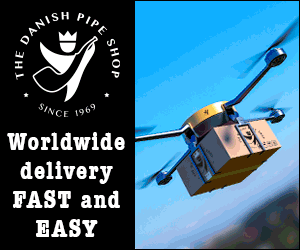by Sykes Wilford, Smokingpipes.com, and Kevin Godbee, Pipesmagazine.com

When one has an opportunity to visit two of the largest pipe tobacco manufacturers in the world on back to back days, comparing the two is all but impossible. Mac Baren and Orlik, between them, produce over half of the world’s pipe tobacco. Along with the Lane factory in Tucker, GA, they make up the big three pipe tobacco producers in the world. And they’re both on the island of Funen that sits between Sjaelland, the largest of the Danish islands, and Jylland, the peninsula that juts off of the European mainland. Indeed, they’re an hour drive apart on either side of the island. Having had a thoroughly hospitable reception at both factories and being tremendously impressed by both operations, we nonetheless found ourselves drawing some comparisons.
Having left Orlik, we started discussing the differences between the two. Perhaps the similarities are more obvious: both operate massive, modern factories, both are fanatically dedicated to the quality of their tobaccos, and both have a long history and make famous brands that have stood the test of time. But this, our dear readers, is about the differences.


For starters, no pun intended, let’s talk about lunch. Typically, large companies have cafeterias. In the United States, outside of Google, such places offer fare that make sixth grade school lunch seem palatable. At both Mac Baren and Orlik, we were pleased to discover that the Danes have a subtly different approach to such things. They serve edible lunches in company cafeterias. Offering traditional Danish comestibles, including black bread, a variety of impressive cheeses and cold meats, paté, and full salad bars, Sykes wants one of these for the Smokingpipes.com campus. Imagine visiting a tobacco company and coming away with company catering ideas. Picking a winner in this category was impossible.
Both Orlik and Mac Baren have machinery that causes otherwise reasonable grown men to act like eight-year-old boys who just saw a backhoe. Conveyor belts, automatic weighing machines, little robotic arms to fold packaging, slides, chutes, and sundry whirring doodads abound, but the nod, if only a half-nod, goes to Mac Baren, who can go from tobacco coming in from the ceiling, to pouches, to cartons, to outer cartons, to palletes, all without ever being touched by a human hand. Orlik was close, requiring slightly more human intervention, but in this category, Mac Baren is a clear winner.

Both factories produce rope tobacco. Rope tobacco is a traditional method of fabricating tobacco for transport, back when finding a way to keep tobacco smokable after a transatlantic journey on a wooden sailing ship was a serious problem. The tobacco is literally spun into ropes: the process lies somewhere in between cigar rolling and rope braiding. But, the factories’ respective methods are a little different. Mac Baren uses whole leaves as something comparable to the binder and filler. Orlik uses thin pressed sheets of tobacco, similar to those used for flakes, but much thinner. Inside, Mac Baren generally uses loose leaf dark fired Kentucky, whereas Orlik uses pressed perique or black cavendish. From this process comes some of the world’s most famous, most tastiest blends, including Mac Baren Roll Cake and, Sykes’ personal favorite, Escudo, which is made by Orlik (which we both happen to be smoking while engaging in this absurd literary exercise). However, the nod goes to Mac Baren in this category, for they have what looks and works like a giant RYO cigarette machine. Frankly, the little machine that presses it into a rope at Orlik just isn’t nearly as cool.

About an hour on the road after our visit to Orlik, Sykes turned to Kevin and said “did the tobacco blender guy make you think mad scientist too?” To which Kevin retorted with a maniacal laugh. Yes, Orlik has its very own evil genius tobacco blender. Here in Denmark they offer a personalized blending service where different stores or individuals can choose to craft their own blend. The idea started in the 1930s and grew into Paul Olsen’s My Own Blend, which Orlik purchased from the Olsen family in the 1980s. Today, roughly eight metric tons of pipe tobacco is custom blended for customers and stores to the exact recipe, based on almost fifty component blends and dozens of flavorings, by Lasse Berg, Chief Evil Tobacco Genius (ok, we made up the title). It is abundantly clear that a) Lasse thinks he has the best job on the planet, and b) he played with chemistry sets as a kid. At one point, he showed us a cola flavored tobacco topping of his own creation, of which he was very proud, but then went on to admit that he doesn’t use it very much because, apparently, no one really thinks of cola as a tobacco flavoring. He went on to create for us, sans cola topping, individualized blends based on our preferences. Sykes’ had more perique, Kevin had more rum. Also, during this exercise, Kevin drank a bit of the rum used on the tobacco (he approves), also giving Orlik the nod for best adult beverages (Mac Baren did not offer adult beverages at 10am when we arrived there). So, two categories at once to Orlik: mad scientist tobacco blender and best adult beverages. Does it surprise anyone that the mad scientist blender was also the keeper of the adult beverages?

While we were visiting Mac Baren, after the factory tour with Per Jensen, who is something between a product development guy and a general Mac Baren evangelist, we sat and had coffee with him. As our conversation meandered from topic to topic, we ended up with Per showing Kevin, with Kevin’s pipe, how to pack flake tobacco by folding it and packing it vertically. So, not only did they humor us with a factory tour, fed us lunch, plied with coffee and tobacco, they even had a Mac Baren executive pack Kevin’s pipe.
On net, it was a tie. Both organizations are impressive and were wonderfully accommodating to two very excited, tobacco crazed Americans.



















It sounds like you guys are having a great time in Denmark!
This was a great read!
Very cool. I’m going to start planning a family vacation to Denmark right now.
That’s just terrific! Nothing beats field trips.
Great read, guys!
Eight metric tons of MOB custom made? Wow, that’s a bit more than I would have guessed …